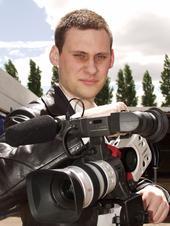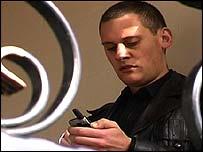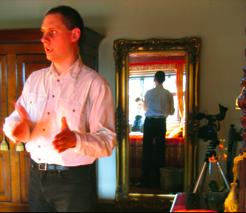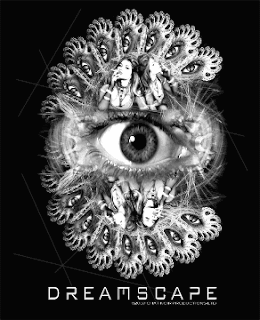 What was the inspiration for Dreamscape and how close is the finished film to what you originally intended?
What was the inspiration for Dreamscape and how close is the finished film to what you originally intended?“The inspiration behind the film was two-fold: firstly a wish to shoot a black and white film and secondly to make a hard-edged, adult sci-fi thriller. The finished film is far more visually ambitious and plot-dense than the 20-minute short we set out to make but the intent behind the film is the same, showing a man believing he can live without consequences and finally getting his come-uppance. The additional material and increased use of special effects simply placed the story within a larger world, allowing some of the background characters to breath.”
What sort of balance did you aim for between special effects and production design supporting the story and a story which gave scope for production design and special effects?
“The script we started shooting in 2005 was for a more intimate and enclosed film, taking place inside - never really venturing into the ‘wider world’. The Conference Centre sequence was about as large as it got and that was using an existing location, which we thankfully had free access to. The intention was to film 90 per cent of the film using real locations but we quickly ran into problems when we started scouting exterior locations for the Sky Plaza building and the Man’s apartment. We were desperately looking for buildings that would give the film scale and scope and although there are some buildings in Liverpool that almost fitted the bill, filming them was another challenge in itself. Anyone who’s been to New York will know that unless you’re a few blocks away from a building, you don’t get any sense of scale. I lost the Empire State and I was one block away!
“Paramount to any film of this type is establishing the geography of the locations in relation to each other and events. My films, by the nature of their narratives, often cross cut between two, three, four locations in any given scene and one of the big lessons Vendetta taught me is how easily audiences get confused if your establishing shots are obscure or missing. Now for a normal low budget film this is relatively easy as your locations are usually houses, pubs, offices etc. The world we were looking to create was something a little more challenging and it just didn’t exist in the real world.
“This isn’t a problem restricted to low budget films. In Total Recall you get no sense of the city Arnold Schwarzenegger’s character lives in. The film settles for using a few glass and concrete buildings in selected exterior shots but you never feel you’re in the heart of a big city. It’s about mindset I think rather than pounds you have to spend.
“In 2005 we started experimenting with CGI effects using Cinema 4D for another project, so I initially asked Joe to model up an exterior view of the Man’s apartment for a handful of shots. These models were never used but they served as a springboard for all the CGI work that was to follow.
“The digital city, which took Joe over a year to build, suddenly opened up the scope of the film-making to an unprecedented degree. Of course there’s a certain amount of spectacle associated with any special effects work but from a director’s point of view it allowed me to start making films the way I’ve always dreamed of. If a location didn’t exist we’d simple build it. Having a simple shot like the Man looking out over the city from his apartment was simply a matter of render times and compositing in the live-action footage. The shot looks stunning but it also tells the story, placing the character firmly within his environment. The story could have been told without CGI environments but it would have been less credible and would have definitely felt like a £5,000 movie.”
What were the advantages and disadvantages to playing the lead role as well as writing, directing and producing?
“The main advantage is very simple: the film is complicated and features action, lots of dialogue and locations. To get an actor to commit to the number of days we were looking at, often at short notice as locations came available, was always going to be difficult. I was going to be on set every day we shot, I knew the script inside out, could write to my strengths and try to avoid my weaknesses. Practically, it was the only way to go to get the film made. If we’d had the money and the full crew, we could have shot the film very quickly, going from scene to scene, and I would happily have brought another actor in to play the part.
“Disadvantages: when you’re acting you’re sometimes unable to see the scene as a whole. Thankfully I have a good team in Mark and Chris so I’m happy to rely on them in those situations. The other main disadvantage is that 90 per cent of the time I place the camera, choose lens length and framing. To simply tell a DP I want a close-up is meaningless to me as the position of the camera and composition of the frame are as vital decisions as choice of costume or set. Putting the camera in the wrong place or with the wrong lens or lighting is like an artist using the wrong shade or type of paint. So while I tweak the lighting before filming a set-up, a member of crew often has to stand in for me, but this rarely slows us down and is simply a variation on what goes on in big budget features.”
 What was the biggest technical challenge in making Dreamscape, and the biggest artistic challenge?
What was the biggest technical challenge in making Dreamscape, and the biggest artistic challenge?“If you put the high number of digital shots to one side for a second, without doubt the greatest technical challenge was looping practically every line of dialogue and re-recording every sound effect. My last film Vendetta used nearly all live-sound and it really brought the overall quality of the film down. The one scene we did dub was insanely tough to do but the results were stunning. A lot of Dreamscape’s locations were hardly sound-friendly so dubbing was the only way to go. ADR is a time-consuming process; getting a performance with life and energy away from the set is always challenging but not impossible and when you see or rather hear it in place, it’s worth the effort.
“Looping footsteps, coat noises, files being moved about, cups picked up and put down are just technical exercises - but by rebuilding the sound from the ground up you can be very specific about what you want the audience to hear. Also nothing is given to you, so you really have to learn not just to put in the necessary sfx, but also miscellaneous ones off in the distance that give the mix the random haphazardness of ‘real life’.
“All these recorded elements then had to be handed over to Joe who mixed them, adding suitable reverb and ambience tracks. Joe’s done several audio plays for Big Finish so he’s used to this kind of ground-up approach to sound. The difference here is the audio is subservient to the visuals and specific sfx are vital to certain visual aspects coming to life.
“The CGI effects were a technical challenge in many ways, but more of an artistic one. The models, which were built and textured by my brother, were detailed to a certain level and then, on a shot-by-shot basis, extra details or additional buildings were added as we used wider angles on the city or showed it from an angle we’d never intended to.
“I’ve shot miniatures before and there the main challenge is making sure (a) the models are big enough and (b) you have sufficient light to give you a believable depth field. In CGI the models are virtual so making them bigger or smaller is done at the click of a mouse. The more complicated the model the longer it takes to render; individual frames took anywhere between an hour and 15 hours! Depth of field is an effect applied to each frame as it finishes so that needs to be tested beforehand, as does the lighting. All this time you’re trying to give a sense of reality and scale, dirt, grime, weathering, atmospheric light - everything that location filming or miniatures give you for free.
“CGI is like painting with boxing gloves on - every time a shot comes out half decent it’s a shock and you study it like crazy to work out why this shot worked so well and the five previously didn’t. Towards the end we got very inventive with the shots and were able to match the lighting with the live-action much closer.”
Why did you opt for black and white photography in such a futuristic film?
“There are a few technical reasons and plenty of artistic ones. Firstly it has nothing to do with Sin City - which is not really a black and white movie, rather a literal extrapolation of the graphic novel. I was obviously aware that the film was being made but carefully steered away from the overly stylised look they were going for.
“I’m a huge B/W movie fan - Citizen Kane, Sweet Smell of Success, Touch of Evil, The Apartment, Seconds, The Manchurian Candidate, Avengers, 1960s Doctor Who - and I just love the look and feel that you can achieve. When we were originally chatting about making the film I pulled DVD after DVD off the shelf and showed them to Mark. Not for things to copy, but just showing how B/W give you a different mood and atmosphere. It also goes back to Orson Welles’ comment to Peter Bogdanovich: “I defy you to show me a good performance in colour.” Now while I don’t necessarily agree with that 100 per cent I do think B/W changes an audience perception of an actor and their performance. You strip out the colour and you’re left with a very stark, stylised world which immediately screams ‘this is a movie’ but also allows you in a strange way to focus on the performance.
“Dreamscape was shot on DV - which doesn’t have the greatest colour range, something I had found rather depressing on Vendetta. However well that was lit, I could never capture what I wanted. If you strip out the colour and reduce everything to shades of white and black you only have to worry about making sure you have sufficient contrast to give you a crisp, sharp image.
“Also, like film, video has to be balanced for daylight or tungsten (light bulbs). If you mix the light you will end up with the daylight blue or the tungsten orange - which is a sure sign of a low budget film. You can compensate by gelling either the lamps or any windows, but that takes time and with the speed we wanted to film would have been an added level of complications. Shooting in black and white you can forget colour temperature and just shoot the film.
“The other aspect I found appealing when shooting B/W is all about separation and that only comes about through careful design. When shooting with colour you can film a man in a light brown jumper against a grey wall and you will easily differentiate where the man stops and wall begins. In B/W there is always the danger that shades can mix and blend - which forces you to be specific about costumes, colours, patterns, wall papers, framing of shots, use of light etc.
“Also, from films like Minority Report I knew the benefits heavy grading of a film can give when trying to incorporate a high number of visual effects. A lot of modern film photography is so crisp, so clean, so artificial that you lose any sense of a real world. This is death for sci-fi which is all fake to begin with. If the look of the film is as plastic as the sets, you’re in big trouble. Starship Troopers and Total Recall: both are horrifically expensive films but they look like overblown TV episodes shot on very big but rather shoddy sets. You compare them to the mood and atmosphere they achieved on Lord of the Rings or any Ridley Scott film and the difference in quality is unbelievable.
“Now Starship Troopers and Total Recall have no excuse for looking cheap; they had lots of money and teams of technicians working on them. We had two or three people and a handful of lights but there was no way I was going to turn in a bad looking movie if we could help it. I never go into a project thinking ‘this is low budget so if it’s not perfect - oh well.’ If the lighting, special effects or a prop aren’t up to industry standard, I lose sleep. Black and white is like a free level of production design for a movie if you use it correctly - a layer of varnish which smoothes and eases often disparate elements together.”
 Why is much of the film set in a convention centre?
Why is much of the film set in a convention centre?“So much of film making at this level is down to practicalities. If you are a writer/director who understands that you can turn this to your advantage, you work with it and make changes to simplified things. The original script always had the trap set in the convention centre, the Man escaped and we never returned there. All of the scenes with the agents that followed were scripted to take place in the ‘Agency’ HQ. Very easy to write.
“About a week before we shot all the scenes with the Secretary in the Agency HQ it became clear the location we’d chosen wasn’t going to work and an alternative had to be found. The only one available was in the same building as we were using for the Conference Centre and there was no way an audience was going to believe they weren’t the same building.
“This is where a little bit of tinkering at the script level allows two locations to become one. A few lines from the Investigator about mobile command centres and the addition of the Conference Centre manager - and the Government agents had lost their HQ and were now dumped in the Conference Centre. The benefit of this was that they were out of their natural environment and didn’t have everything they needed at their finger tips, giving them a nice dislocated feel. They’re having to make do, sleep in the lobby, borrow offices, while they search the building for clues. It also allows for a bit of fun with the idea that: whenever a big security operation like this happens, how many people going about their day-to-day jobs suddenly go into limbo until the authorities have finished their work?
“For us, it meant we could light and shoot all the Secretary’s office scenes in one day, filming from two till nine at night. Let no one ever say I don’t shoot scenes fast and then collapse before the next day’s shooting. The building is interesting to film in, gives you lots nice angles, we did have the free run of the place which is always helpful and on this level of film making you have to use everything that’s free to the max.”
What is your background in film-making and how did you bring the Chat Noir team together?
”I met Mark (DP and co-producer) at High School and, for as long as I can remember, I’ve been writing scripts and he’s been editing them. He has a large folder somewhere in his house with over 15 years’ worth of scripts in various states of completion. These ranged from blockbusters to TV, new Star Trek films to horror movies - always sci-fi/fantasy, often with James Bond elements, always insanely ambitious!
“I’ve always had a fascination with film and TV - and even from a very early age in the mechanics and trickery involved. I was brought up on Captain Scarlet repeats, Doctor Who, Thunderbirds, Stingray and my tastes have stayed in that area. I like programmes and films that use all the tricks, crafts and arts to their fullest. A kitchen sink drama would have about as much appeal to me as a dose of botulism - there is simply no challenge. Also I like films and TV that entertain and take you places as a viewer. If I want to see ‘real life’ (which is a conceit anyway as all films are highly manipulative constructs) I’ll hop on a bus.
“Through my teens I bought every book on make-up, special effects, cameras etc. This was when making of books actually had something interesting to say rather than ‘we built it in a computer.’ The language of film to me is close-up, long, pan etc. but it also includes matte-painting, rotoscope, miniatures, forced perspective. These are never tricks for tricks’ sake, simply other tools in a director’s armoury. To me this is how films are made - the technique is never of interest, simply the result.
“I brought all these crazy ideas with me when I went to University in Wrexham. I turned up with boxes of puppet heads and prosthetics, folder after folder of storyboards for some minor sci-fi epic. I don’t think they really knew what to make of it all - but asked would I be happy filming on location. I wasn’t sure what that meant, but quickly learnt. The University didn’t have any studio space so any films had to be made on the streets or in whatever location we could be borrow or steal. Now this was a challenge, shall we say, for a fresh-faced student ready to make his version of Blade Runner or Star Wars but thankfully the group of lads on the course were just as insane as I was and we knuckled down to it and taught ourselves how to make films.
“Mark had no plans for university so I suggested he join the course. He’d just finished a stage management course at college (specialising in lighting) and jumped at the chance.
“Four years later I left with a rather swanky BA (Hons) first class - for a degree we’d convinced the University to create for our group. In that time I’d made a good number of films, music videos and promos. Mindfield, a sci-fi short, had make-up effects, prop guns, a miniature cityscape, a miniature nuclear missile complete with silo. In many ways it was a cut down, underdeveloped version of what Dreamscape would later become. Against university rules, it featured guns and fighting - but I didn’t care. This was the film I wanted to make.
“I made lots of mistakes and learnt what worked and almost immediately ploughed this newly acquired knowledge into making Vendetta. Filmed over two years as my final graduation project, Vendetta was made in the mould of Get Carter or my vision for Bond (hard and played straight - basically the approach Casino Royale took). Despite being a contemporary film, this didn’t limit the scope I had in mind. Location filming took place in Northern California (San Francisco and Eureka) on a holiday, doubling for Sicily of all places. Other locations included London, Greece, Wrexham and Chester. The film was entered for a number of festivals and won Best International Short Film at the New York International Independent Film and Video Festival.
“I’ve obviously known my brother Joe - well, since he was born and it was just happy coincidence that he’s followed a career in music and sound. Also helpful is that we share a very close idea on what music should do in film, our tastes having been fashioned by the works of John Williams, Jerry Goldsmith, Ennio Morricone and Barry Gray.
“Chris Owen I met a university and I cast him in a small role in Vendetta. When we started work on Dreamscape I gave him a larger role but by then I’d got to know him a bit better and realised he was also a very talented cameraman and director in his own right.
“My sister Abi took on the role of executive producer towards the end of production, bringing a fresh eye to the project when Mark, Joe and myself were beginning to flag. She wrote and directed a documentary in 2004, which I helped her to film and edit. This won an award in San Antonio.”
 What are your plans for the future?
What are your plans for the future?“In the short term, getting the word about Dreamscape out there and hopefully finding a distributor for it. If that involves adding another fifteen minutes, that’s something we can do with ease. An extended screenplay has been written which adds a third act and also reworks several earlier scenes to clarify certain plot points. The scope of the film would go up another notch - as would the style of the film. The camera work, editing, music and acting were always designed to change as the film progressed:
“Act 1: Very composed shots, stylised acting, 1930s-ish. Act 2: More camera movement, more 1960s, Dirty Harry, acting a little more natural but still larger than life. Act 3: Camera very fluid, insane virtual camera moves, more hand-held work, Tony Scott-style lens usage and editing, very 1990s.
“Obviously any extension to the third act would continue the modern action movie feel, while scenes added earlier to the film would be tailored to the respective shooting styles of the act they are in.
“Cast and crew have put a lot of work into the film and while we have the press interest and good will, an extended cut, which we could get onto DVD, is probably the way we’re going to do. And who knows, one day both cuts may be out there on a special edition - it worked for Dark Star! I have several other feature screenplays in the last stages of development which we’ll be looking to get financing for. Dreamscape has been a testing ground for many techniques and going into any new project we’d of course take all that with us.
“Digital technology - be it cameras, editing systems or CGI - means that if you can imagine something and have the skill, you don’t need hundreds of millions of dollars to get it on screen. You can’t produce visuals to rival ILM, but you no longer need to be restricted by what you can practically film on the day. A more optimistic person would hope this would be the last nail in the coffin for the kitchen sink mindset that seems to permeate English film-making. Sadly nothing will change in the short term and English movies will continue not to make money. I however find the opportunities digital offers excite me the same way watching Thunderbirds or Star Wars for the first time did as a kid. Dreamscape is only a small taste of the kind of films I intend to make. You really ain’t seen nothing yet...”
website: www.chatnoirproductions.co.uk
interview originally posted 5th August 2007
No comments:
Post a Comment